Management Accounting Report: Performance, Budgeting, and Variance
VerifiedAdded on 2020/01/07
|16
|4942
|164
Report
AI Summary
This report provides a comprehensive analysis of management accounting principles, focusing on cost classification, gross profit calculations, and expenditure types for Columbus Ltd and Steel Ltd. It delves into cost of production reports, performance indicators for improvement, and the purpose and methods of the budgeting process. The report also includes comparative budgets and a detailed variance analysis of Yuri's budget, along with the preparation of an operating statement and a memorandum report. The study covers various tasks such as cost analysis, improvement strategies, and the nature of the budgeting process, offering valuable insights into financial management and decision-making within organizations. The report concludes with a summary of the findings and recommendations for improvement.
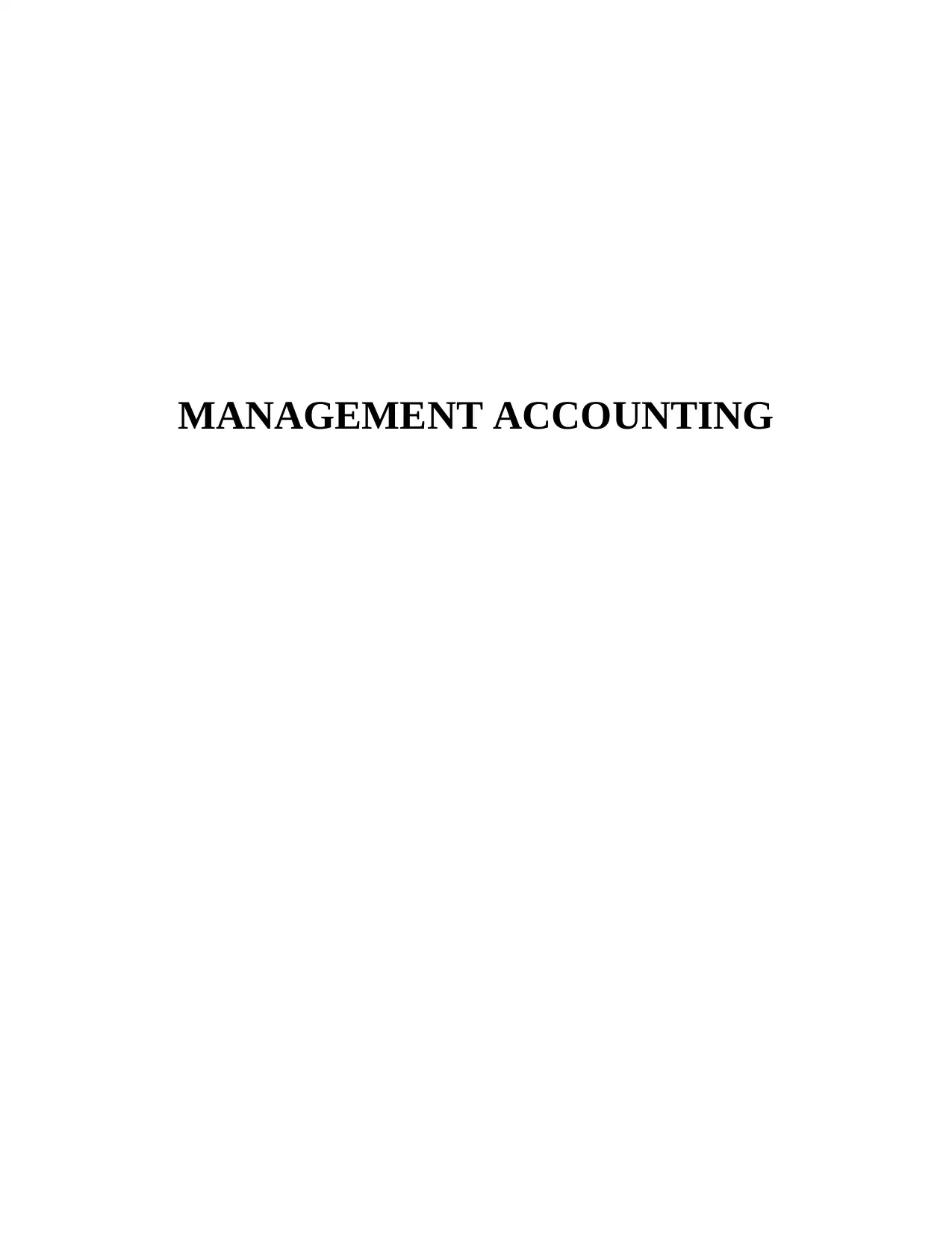
MANAGEMENT ACCOUNTING
Paraphrase This Document
Need a fresh take? Get an instant paraphrase of this document with our AI Paraphraser
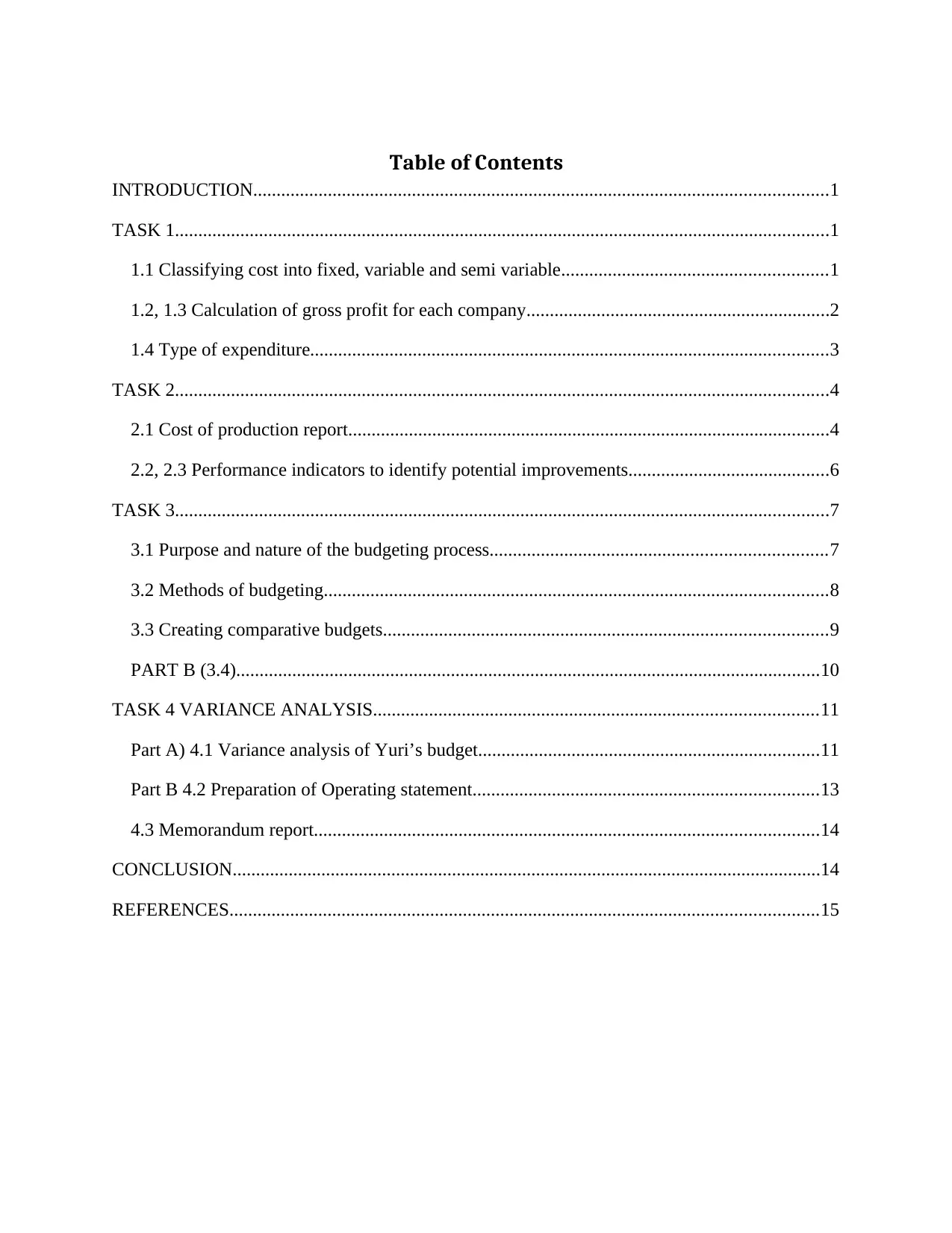
Table of Contents
INTRODUCTION...........................................................................................................................1
TASK 1............................................................................................................................................1
1.1 Classifying cost into fixed, variable and semi variable.........................................................1
1.2, 1.3 Calculation of gross profit for each company.................................................................2
1.4 Type of expenditure...............................................................................................................3
TASK 2............................................................................................................................................4
2.1 Cost of production report.......................................................................................................4
2.2, 2.3 Performance indicators to identify potential improvements...........................................6
TASK 3............................................................................................................................................7
3.1 Purpose and nature of the budgeting process........................................................................7
3.2 Methods of budgeting............................................................................................................8
3.3 Creating comparative budgets...............................................................................................9
PART B (3.4).............................................................................................................................10
TASK 4 VARIANCE ANALYSIS...............................................................................................11
Part A) 4.1 Variance analysis of Yuri’s budget.........................................................................11
Part B 4.2 Preparation of Operating statement..........................................................................13
4.3 Memorandum report............................................................................................................14
CONCLUSION..............................................................................................................................14
REFERENCES..............................................................................................................................15
INTRODUCTION...........................................................................................................................1
TASK 1............................................................................................................................................1
1.1 Classifying cost into fixed, variable and semi variable.........................................................1
1.2, 1.3 Calculation of gross profit for each company.................................................................2
1.4 Type of expenditure...............................................................................................................3
TASK 2............................................................................................................................................4
2.1 Cost of production report.......................................................................................................4
2.2, 2.3 Performance indicators to identify potential improvements...........................................6
TASK 3............................................................................................................................................7
3.1 Purpose and nature of the budgeting process........................................................................7
3.2 Methods of budgeting............................................................................................................8
3.3 Creating comparative budgets...............................................................................................9
PART B (3.4).............................................................................................................................10
TASK 4 VARIANCE ANALYSIS...............................................................................................11
Part A) 4.1 Variance analysis of Yuri’s budget.........................................................................11
Part B 4.2 Preparation of Operating statement..........................................................................13
4.3 Memorandum report............................................................................................................14
CONCLUSION..............................................................................................................................14
REFERENCES..............................................................................................................................15
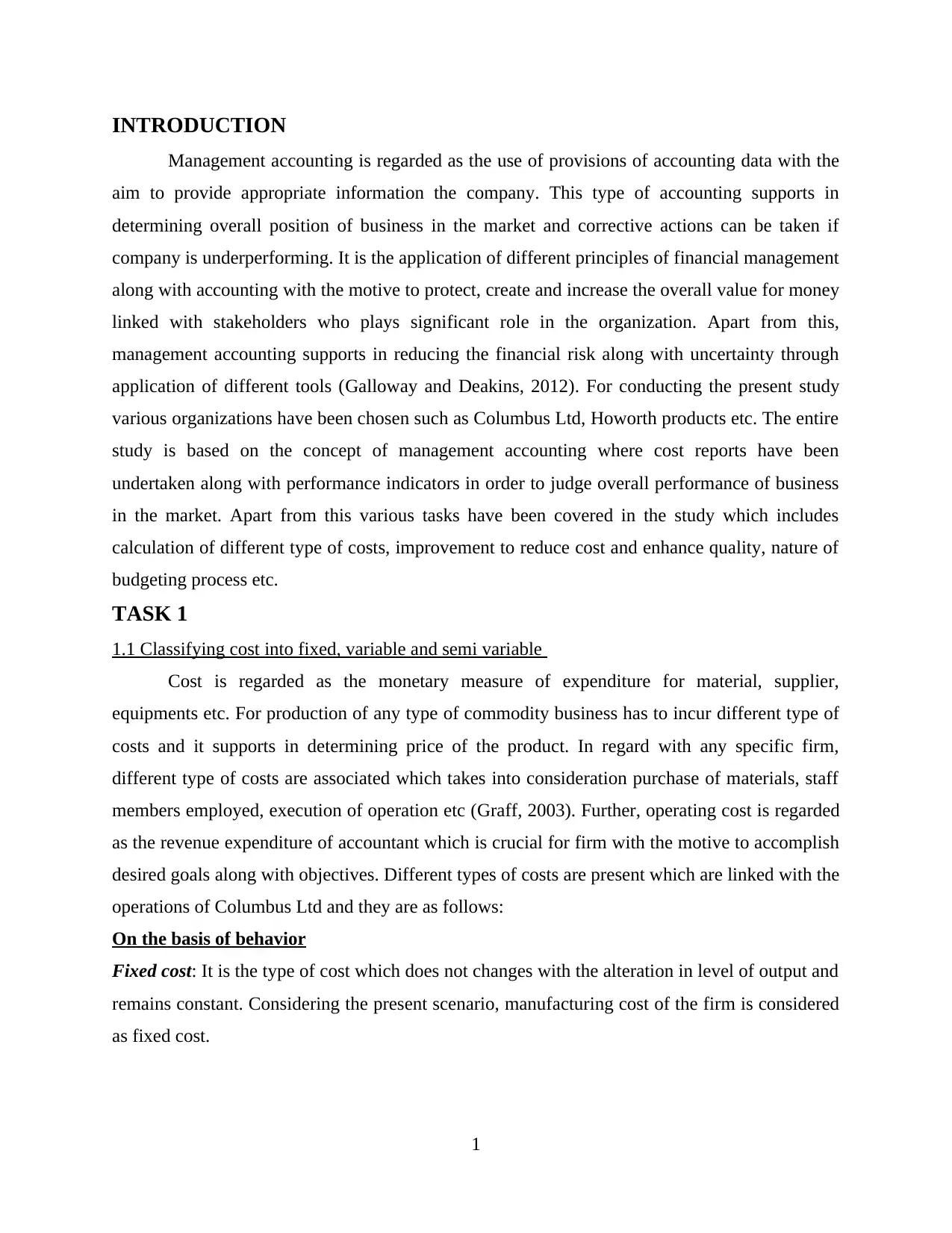
INTRODUCTION
Management accounting is regarded as the use of provisions of accounting data with the
aim to provide appropriate information the company. This type of accounting supports in
determining overall position of business in the market and corrective actions can be taken if
company is underperforming. It is the application of different principles of financial management
along with accounting with the motive to protect, create and increase the overall value for money
linked with stakeholders who plays significant role in the organization. Apart from this,
management accounting supports in reducing the financial risk along with uncertainty through
application of different tools (Galloway and Deakins, 2012). For conducting the present study
various organizations have been chosen such as Columbus Ltd, Howorth products etc. The entire
study is based on the concept of management accounting where cost reports have been
undertaken along with performance indicators in order to judge overall performance of business
in the market. Apart from this various tasks have been covered in the study which includes
calculation of different type of costs, improvement to reduce cost and enhance quality, nature of
budgeting process etc.
TASK 1
1.1 Classifying cost into fixed, variable and semi variable
Cost is regarded as the monetary measure of expenditure for material, supplier,
equipments etc. For production of any type of commodity business has to incur different type of
costs and it supports in determining price of the product. In regard with any specific firm,
different type of costs are associated which takes into consideration purchase of materials, staff
members employed, execution of operation etc (Graff, 2003). Further, operating cost is regarded
as the revenue expenditure of accountant which is crucial for firm with the motive to accomplish
desired goals along with objectives. Different types of costs are present which are linked with the
operations of Columbus Ltd and they are as follows:
On the basis of behavior
Fixed cost: It is the type of cost which does not changes with the alteration in level of output and
remains constant. Considering the present scenario, manufacturing cost of the firm is considered
as fixed cost.
1
Management accounting is regarded as the use of provisions of accounting data with the
aim to provide appropriate information the company. This type of accounting supports in
determining overall position of business in the market and corrective actions can be taken if
company is underperforming. It is the application of different principles of financial management
along with accounting with the motive to protect, create and increase the overall value for money
linked with stakeholders who plays significant role in the organization. Apart from this,
management accounting supports in reducing the financial risk along with uncertainty through
application of different tools (Galloway and Deakins, 2012). For conducting the present study
various organizations have been chosen such as Columbus Ltd, Howorth products etc. The entire
study is based on the concept of management accounting where cost reports have been
undertaken along with performance indicators in order to judge overall performance of business
in the market. Apart from this various tasks have been covered in the study which includes
calculation of different type of costs, improvement to reduce cost and enhance quality, nature of
budgeting process etc.
TASK 1
1.1 Classifying cost into fixed, variable and semi variable
Cost is regarded as the monetary measure of expenditure for material, supplier,
equipments etc. For production of any type of commodity business has to incur different type of
costs and it supports in determining price of the product. In regard with any specific firm,
different type of costs are associated which takes into consideration purchase of materials, staff
members employed, execution of operation etc (Graff, 2003). Further, operating cost is regarded
as the revenue expenditure of accountant which is crucial for firm with the motive to accomplish
desired goals along with objectives. Different types of costs are present which are linked with the
operations of Columbus Ltd and they are as follows:
On the basis of behavior
Fixed cost: It is the type of cost which does not changes with the alteration in level of output and
remains constant. Considering the present scenario, manufacturing cost of the firm is considered
as fixed cost.
1
⊘ This is a preview!⊘
Do you want full access?
Subscribe today to unlock all pages.

Trusted by 1+ million students worldwide
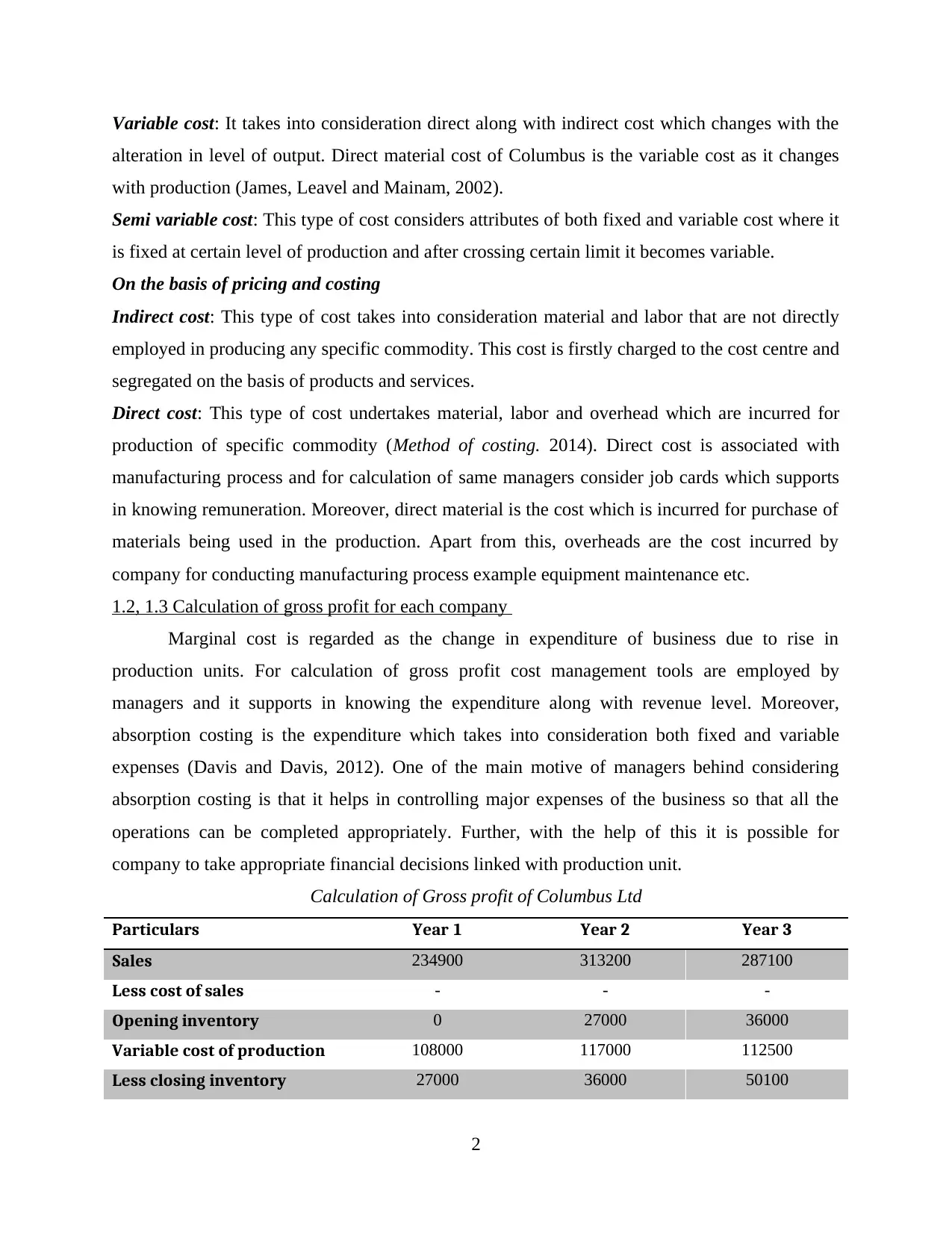
Variable cost: It takes into consideration direct along with indirect cost which changes with the
alteration in level of output. Direct material cost of Columbus is the variable cost as it changes
with production (James, Leavel and Mainam, 2002).
Semi variable cost: This type of cost considers attributes of both fixed and variable cost where it
is fixed at certain level of production and after crossing certain limit it becomes variable.
On the basis of pricing and costing
Indirect cost: This type of cost takes into consideration material and labor that are not directly
employed in producing any specific commodity. This cost is firstly charged to the cost centre and
segregated on the basis of products and services.
Direct cost: This type of cost undertakes material, labor and overhead which are incurred for
production of specific commodity (Method of costing. 2014). Direct cost is associated with
manufacturing process and for calculation of same managers consider job cards which supports
in knowing remuneration. Moreover, direct material is the cost which is incurred for purchase of
materials being used in the production. Apart from this, overheads are the cost incurred by
company for conducting manufacturing process example equipment maintenance etc.
1.2, 1.3 Calculation of gross profit for each company
Marginal cost is regarded as the change in expenditure of business due to rise in
production units. For calculation of gross profit cost management tools are employed by
managers and it supports in knowing the expenditure along with revenue level. Moreover,
absorption costing is the expenditure which takes into consideration both fixed and variable
expenses (Davis and Davis, 2012). One of the main motive of managers behind considering
absorption costing is that it helps in controlling major expenses of the business so that all the
operations can be completed appropriately. Further, with the help of this it is possible for
company to take appropriate financial decisions linked with production unit.
Calculation of Gross profit of Columbus Ltd
Particulars Year 1 Year 2 Year 3
Sales 234900 313200 287100
Less cost of sales - - -
Opening inventory 0 27000 36000
Variable cost of production 108000 117000 112500
Less closing inventory 27000 36000 50100
2
alteration in level of output. Direct material cost of Columbus is the variable cost as it changes
with production (James, Leavel and Mainam, 2002).
Semi variable cost: This type of cost considers attributes of both fixed and variable cost where it
is fixed at certain level of production and after crossing certain limit it becomes variable.
On the basis of pricing and costing
Indirect cost: This type of cost takes into consideration material and labor that are not directly
employed in producing any specific commodity. This cost is firstly charged to the cost centre and
segregated on the basis of products and services.
Direct cost: This type of cost undertakes material, labor and overhead which are incurred for
production of specific commodity (Method of costing. 2014). Direct cost is associated with
manufacturing process and for calculation of same managers consider job cards which supports
in knowing remuneration. Moreover, direct material is the cost which is incurred for purchase of
materials being used in the production. Apart from this, overheads are the cost incurred by
company for conducting manufacturing process example equipment maintenance etc.
1.2, 1.3 Calculation of gross profit for each company
Marginal cost is regarded as the change in expenditure of business due to rise in
production units. For calculation of gross profit cost management tools are employed by
managers and it supports in knowing the expenditure along with revenue level. Moreover,
absorption costing is the expenditure which takes into consideration both fixed and variable
expenses (Davis and Davis, 2012). One of the main motive of managers behind considering
absorption costing is that it helps in controlling major expenses of the business so that all the
operations can be completed appropriately. Further, with the help of this it is possible for
company to take appropriate financial decisions linked with production unit.
Calculation of Gross profit of Columbus Ltd
Particulars Year 1 Year 2 Year 3
Sales 234900 313200 287100
Less cost of sales - - -
Opening inventory 0 27000 36000
Variable cost of production 108000 117000 112500
Less closing inventory 27000 36000 50100
2
Paraphrase This Document
Need a fresh take? Get an instant paraphrase of this document with our AI Paraphraser
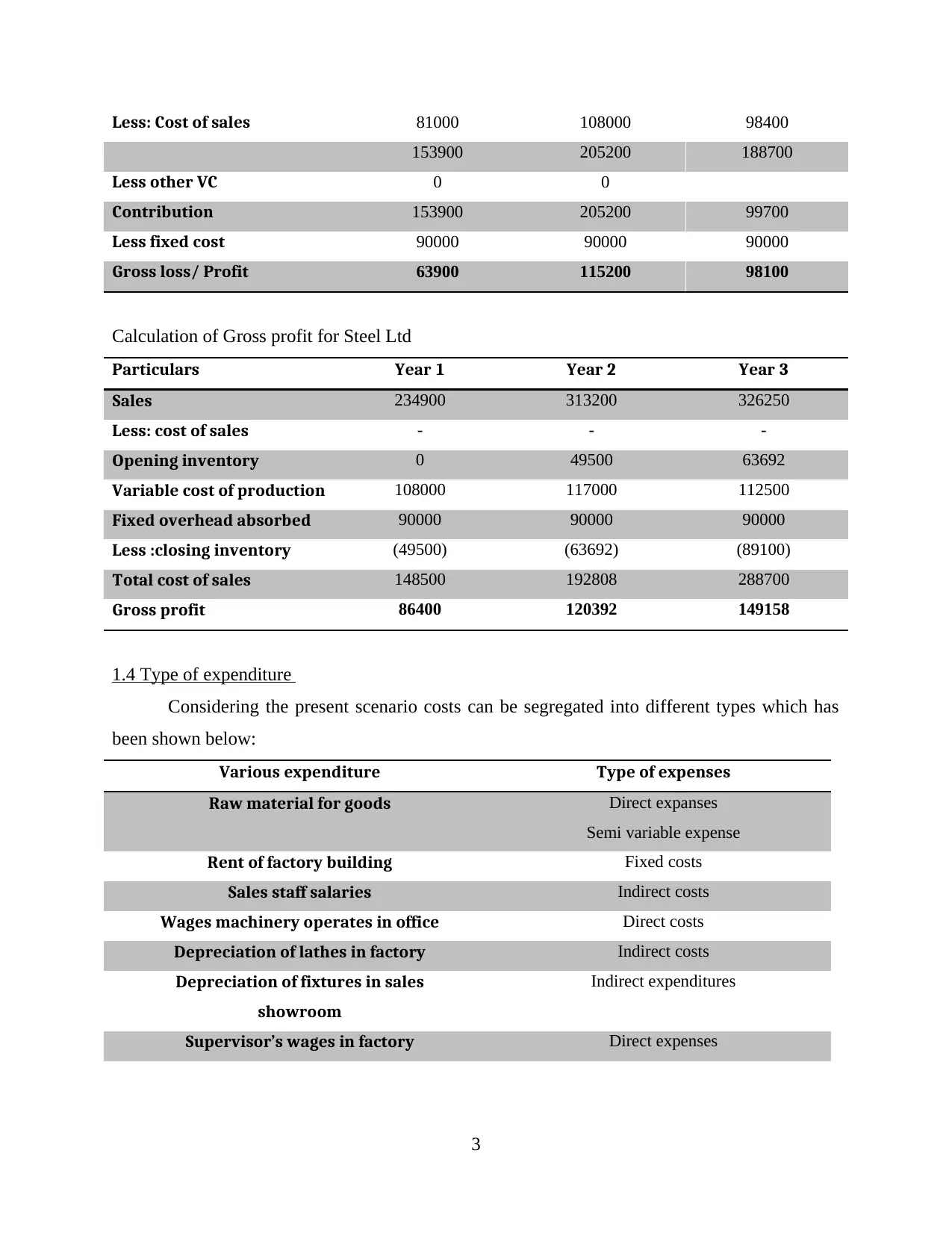
Less: Cost of sales 81000 108000 98400
153900 205200 188700
Less other VC 0 0
Contribution 153900 205200 99700
Less fixed cost 90000 90000 90000
Gross loss/ Profit 63900 115200 98100
Calculation of Gross profit for Steel Ltd
Particulars Year 1 Year 2 Year 3
Sales 234900 313200 326250
Less: cost of sales - - -
Opening inventory 0 49500 63692
Variable cost of production 108000 117000 112500
Fixed overhead absorbed 90000 90000 90000
Less :closing inventory (49500) (63692) (89100)
Total cost of sales 148500 192808 288700
Gross profit 86400 120392 149158
1.4 Type of expenditure
Considering the present scenario costs can be segregated into different types which has
been shown below:
Various expenditure Type of expenses
Raw material for goods Direct expanses
Semi variable expense
Rent of factory building Fixed costs
Sales staff salaries Indirect costs
Wages machinery operates in office Direct costs
Depreciation of lathes in factory Indirect costs
Depreciation of fixtures in sales
showroom
Indirect expenditures
Supervisor’s wages in factory Direct expenses
3
153900 205200 188700
Less other VC 0 0
Contribution 153900 205200 99700
Less fixed cost 90000 90000 90000
Gross loss/ Profit 63900 115200 98100
Calculation of Gross profit for Steel Ltd
Particulars Year 1 Year 2 Year 3
Sales 234900 313200 326250
Less: cost of sales - - -
Opening inventory 0 49500 63692
Variable cost of production 108000 117000 112500
Fixed overhead absorbed 90000 90000 90000
Less :closing inventory (49500) (63692) (89100)
Total cost of sales 148500 192808 288700
Gross profit 86400 120392 149158
1.4 Type of expenditure
Considering the present scenario costs can be segregated into different types which has
been shown below:
Various expenditure Type of expenses
Raw material for goods Direct expanses
Semi variable expense
Rent of factory building Fixed costs
Sales staff salaries Indirect costs
Wages machinery operates in office Direct costs
Depreciation of lathes in factory Indirect costs
Depreciation of fixtures in sales
showroom
Indirect expenditures
Supervisor’s wages in factory Direct expenses
3
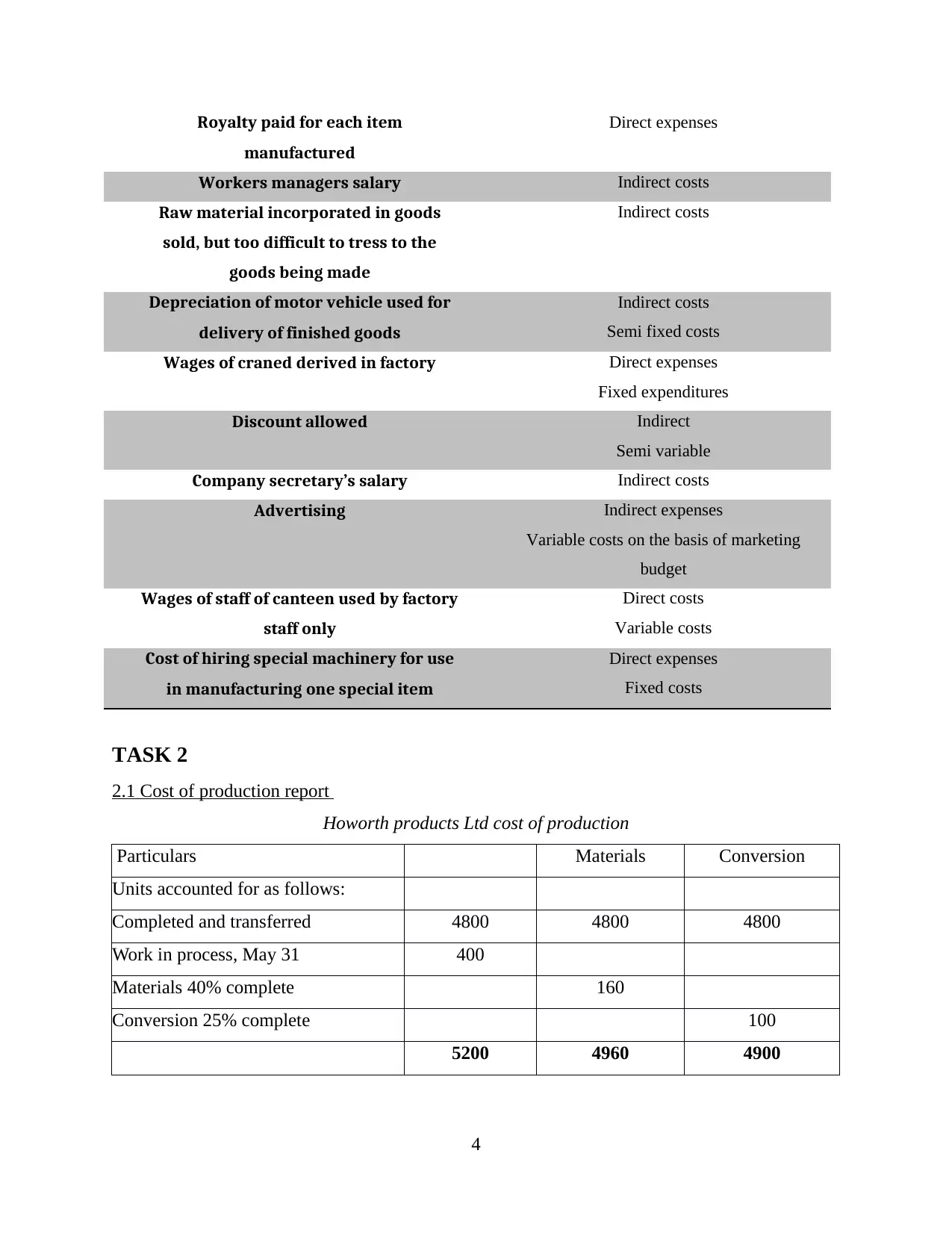
Royalty paid for each item
manufactured
Direct expenses
Workers managers salary Indirect costs
Raw material incorporated in goods
sold, but too difficult to tress to the
goods being made
Indirect costs
Depreciation of motor vehicle used for
delivery of finished goods
Indirect costs
Semi fixed costs
Wages of craned derived in factory Direct expenses
Fixed expenditures
Discount allowed Indirect
Semi variable
Company secretary’s salary Indirect costs
Advertising Indirect expenses
Variable costs on the basis of marketing
budget
Wages of staff of canteen used by factory
staff only
Direct costs
Variable costs
Cost of hiring special machinery for use
in manufacturing one special item
Direct expenses
Fixed costs
TASK 2
2.1 Cost of production report
Howorth products Ltd cost of production
Particulars Materials Conversion
Units accounted for as follows:
Completed and transferred 4800 4800 4800
Work in process, May 31 400
Materials 40% complete 160
Conversion 25% complete 100
5200 4960 4900
4
manufactured
Direct expenses
Workers managers salary Indirect costs
Raw material incorporated in goods
sold, but too difficult to tress to the
goods being made
Indirect costs
Depreciation of motor vehicle used for
delivery of finished goods
Indirect costs
Semi fixed costs
Wages of craned derived in factory Direct expenses
Fixed expenditures
Discount allowed Indirect
Semi variable
Company secretary’s salary Indirect costs
Advertising Indirect expenses
Variable costs on the basis of marketing
budget
Wages of staff of canteen used by factory
staff only
Direct costs
Variable costs
Cost of hiring special machinery for use
in manufacturing one special item
Direct expenses
Fixed costs
TASK 2
2.1 Cost of production report
Howorth products Ltd cost of production
Particulars Materials Conversion
Units accounted for as follows:
Completed and transferred 4800 4800 4800
Work in process, May 31 400
Materials 40% complete 160
Conversion 25% complete 100
5200 4960 4900
4
⊘ This is a preview!⊘
Do you want full access?
Subscribe today to unlock all pages.

Trusted by 1+ million students worldwide
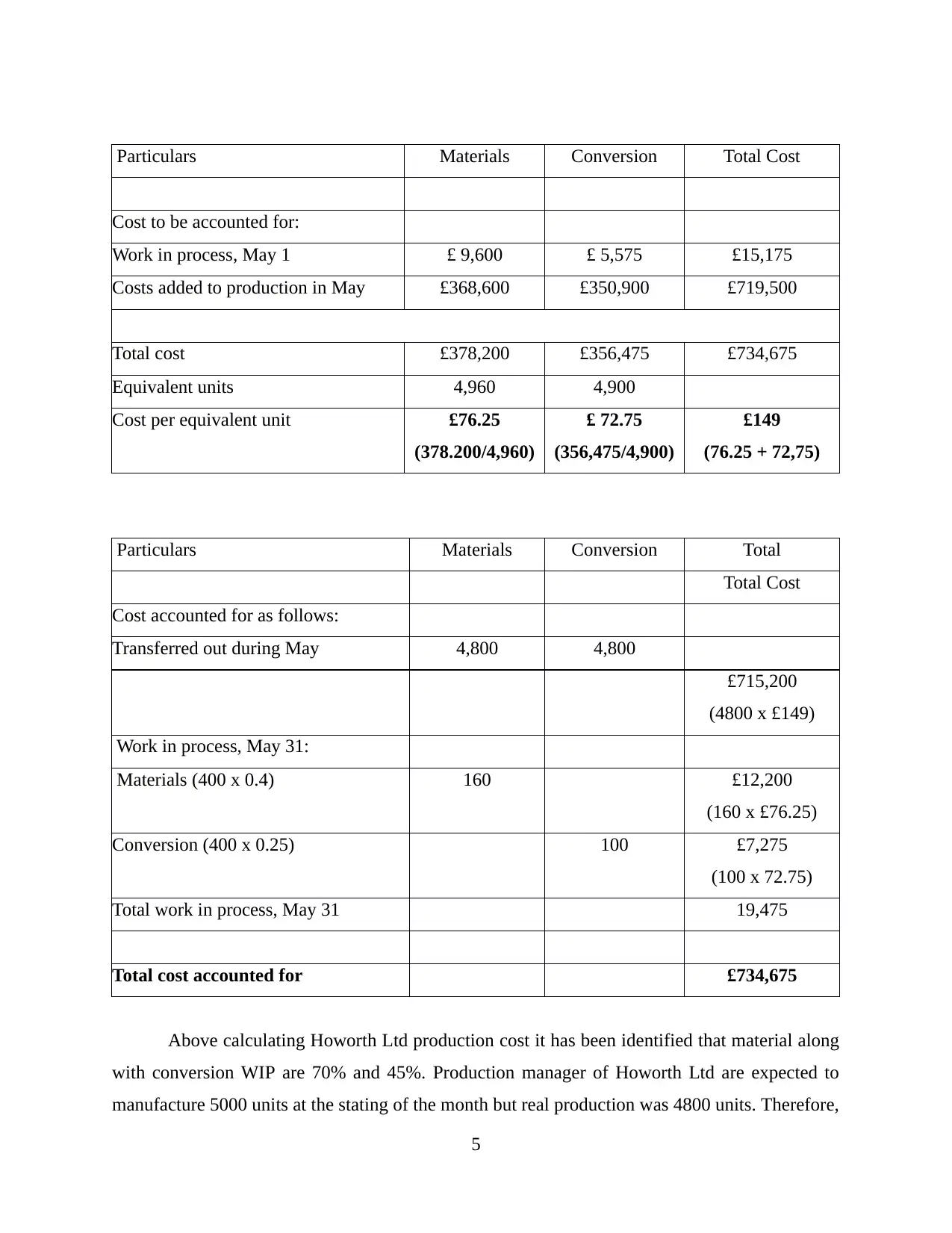
Particulars Materials Conversion Total Cost
Cost to be accounted for:
Work in process, May 1 £ 9,600 £ 5,575 £15,175
Costs added to production in May £368,600 £350,900 £719,500
Total cost £378,200 £356,475 £734,675
Equivalent units 4,960 4,900
Cost per equivalent unit £76.25
(378.200/4,960)
£ 72.75
(356,475/4,900)
£149
(76.25 + 72,75)
Particulars Materials Conversion Total
Total Cost
Cost accounted for as follows:
Transferred out during May 4,800 4,800
£715,200
(4800 x £149)
Work in process, May 31:
Materials (400 x 0.4) 160 £12,200
(160 x £76.25)
Conversion (400 x 0.25) 100 £7,275
(100 x 72.75)
Total work in process, May 31 19,475
Total cost accounted for £734,675
Above calculating Howorth Ltd production cost it has been identified that material along
with conversion WIP are 70% and 45%. Production manager of Howorth Ltd are expected to
manufacture 5000 units at the stating of the month but real production was 4800 units. Therefore,
5
Cost to be accounted for:
Work in process, May 1 £ 9,600 £ 5,575 £15,175
Costs added to production in May £368,600 £350,900 £719,500
Total cost £378,200 £356,475 £734,675
Equivalent units 4,960 4,900
Cost per equivalent unit £76.25
(378.200/4,960)
£ 72.75
(356,475/4,900)
£149
(76.25 + 72,75)
Particulars Materials Conversion Total
Total Cost
Cost accounted for as follows:
Transferred out during May 4,800 4,800
£715,200
(4800 x £149)
Work in process, May 31:
Materials (400 x 0.4) 160 £12,200
(160 x £76.25)
Conversion (400 x 0.25) 100 £7,275
(100 x 72.75)
Total work in process, May 31 19,475
Total cost accounted for £734,675
Above calculating Howorth Ltd production cost it has been identified that material along
with conversion WIP are 70% and 45%. Production manager of Howorth Ltd are expected to
manufacture 5000 units at the stating of the month but real production was 4800 units. Therefore,
5
Paraphrase This Document
Need a fresh take? Get an instant paraphrase of this document with our AI Paraphraser
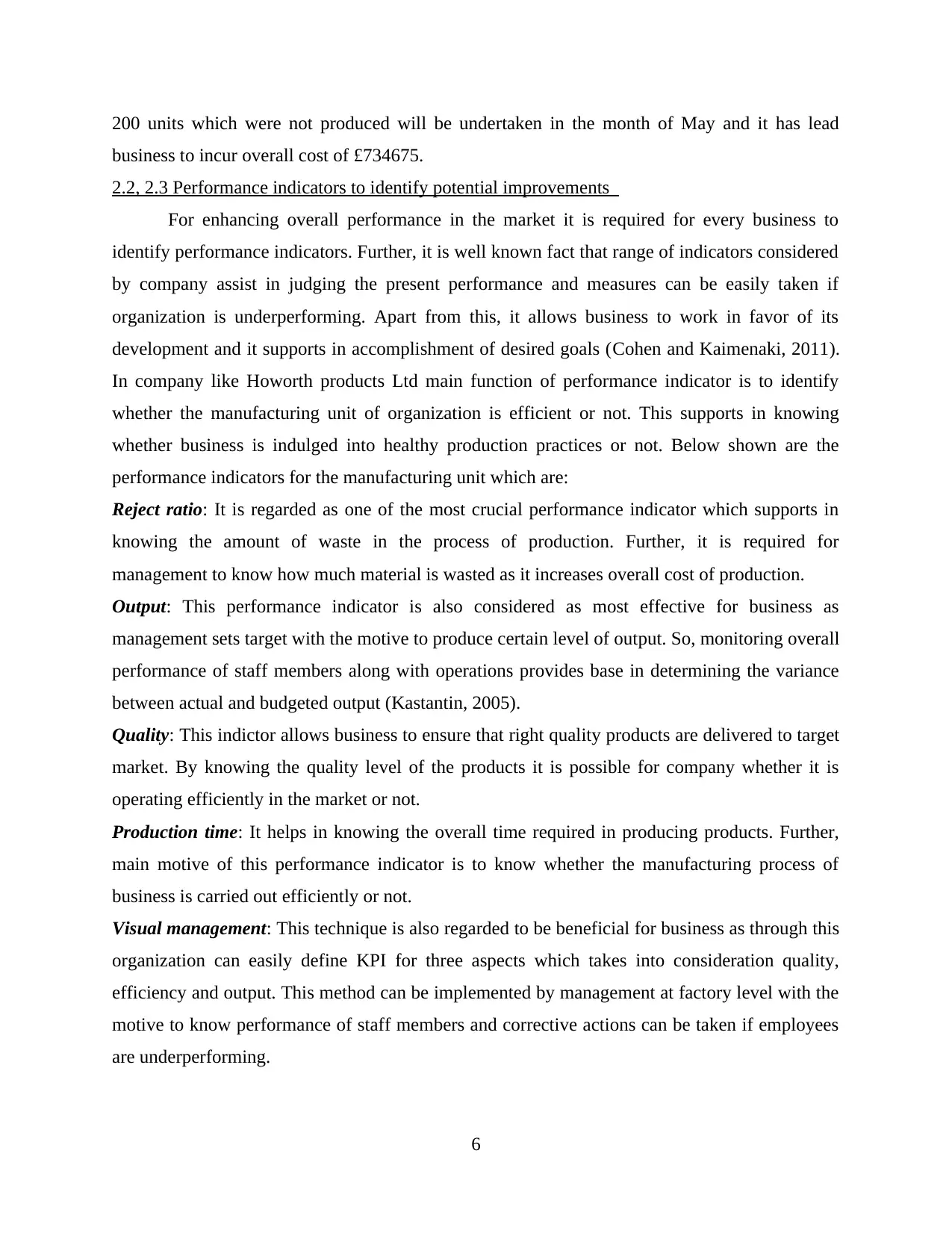
200 units which were not produced will be undertaken in the month of May and it has lead
business to incur overall cost of £734675.
2.2, 2.3 Performance indicators to identify potential improvements
For enhancing overall performance in the market it is required for every business to
identify performance indicators. Further, it is well known fact that range of indicators considered
by company assist in judging the present performance and measures can be easily taken if
organization is underperforming. Apart from this, it allows business to work in favor of its
development and it supports in accomplishment of desired goals (Cohen and Kaimenaki, 2011).
In company like Howorth products Ltd main function of performance indicator is to identify
whether the manufacturing unit of organization is efficient or not. This supports in knowing
whether business is indulged into healthy production practices or not. Below shown are the
performance indicators for the manufacturing unit which are:
Reject ratio: It is regarded as one of the most crucial performance indicator which supports in
knowing the amount of waste in the process of production. Further, it is required for
management to know how much material is wasted as it increases overall cost of production.
Output: This performance indicator is also considered as most effective for business as
management sets target with the motive to produce certain level of output. So, monitoring overall
performance of staff members along with operations provides base in determining the variance
between actual and budgeted output (Kastantin, 2005).
Quality: This indictor allows business to ensure that right quality products are delivered to target
market. By knowing the quality level of the products it is possible for company whether it is
operating efficiently in the market or not.
Production time: It helps in knowing the overall time required in producing products. Further,
main motive of this performance indicator is to know whether the manufacturing process of
business is carried out efficiently or not.
Visual management: This technique is also regarded to be beneficial for business as through this
organization can easily define KPI for three aspects which takes into consideration quality,
efficiency and output. This method can be implemented by management at factory level with the
motive to know performance of staff members and corrective actions can be taken if employees
are underperforming.
6
business to incur overall cost of £734675.
2.2, 2.3 Performance indicators to identify potential improvements
For enhancing overall performance in the market it is required for every business to
identify performance indicators. Further, it is well known fact that range of indicators considered
by company assist in judging the present performance and measures can be easily taken if
organization is underperforming. Apart from this, it allows business to work in favor of its
development and it supports in accomplishment of desired goals (Cohen and Kaimenaki, 2011).
In company like Howorth products Ltd main function of performance indicator is to identify
whether the manufacturing unit of organization is efficient or not. This supports in knowing
whether business is indulged into healthy production practices or not. Below shown are the
performance indicators for the manufacturing unit which are:
Reject ratio: It is regarded as one of the most crucial performance indicator which supports in
knowing the amount of waste in the process of production. Further, it is required for
management to know how much material is wasted as it increases overall cost of production.
Output: This performance indicator is also considered as most effective for business as
management sets target with the motive to produce certain level of output. So, monitoring overall
performance of staff members along with operations provides base in determining the variance
between actual and budgeted output (Kastantin, 2005).
Quality: This indictor allows business to ensure that right quality products are delivered to target
market. By knowing the quality level of the products it is possible for company whether it is
operating efficiently in the market or not.
Production time: It helps in knowing the overall time required in producing products. Further,
main motive of this performance indicator is to know whether the manufacturing process of
business is carried out efficiently or not.
Visual management: This technique is also regarded to be beneficial for business as through this
organization can easily define KPI for three aspects which takes into consideration quality,
efficiency and output. This method can be implemented by management at factory level with the
motive to know performance of staff members and corrective actions can be taken if employees
are underperforming.
6
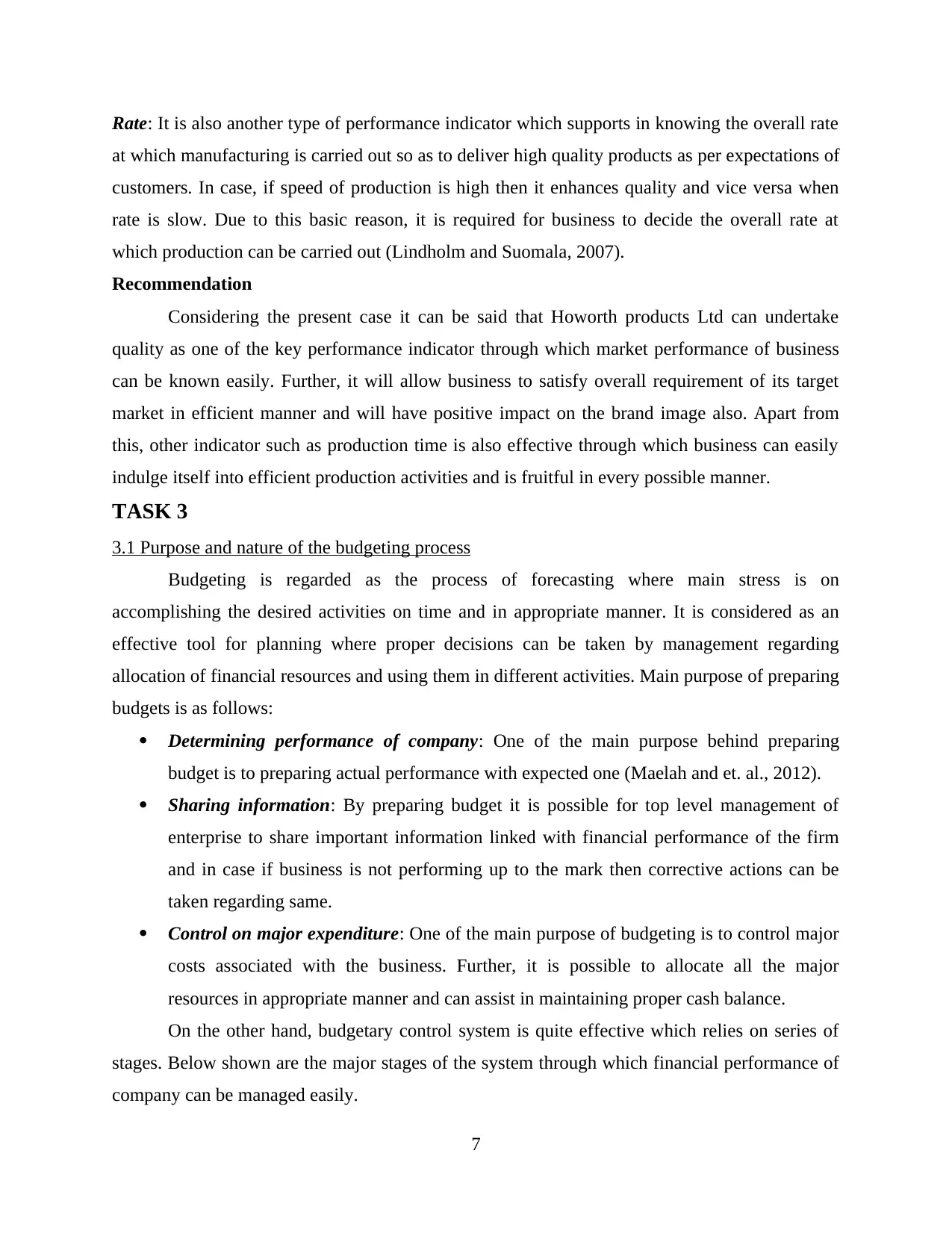
Rate: It is also another type of performance indicator which supports in knowing the overall rate
at which manufacturing is carried out so as to deliver high quality products as per expectations of
customers. In case, if speed of production is high then it enhances quality and vice versa when
rate is slow. Due to this basic reason, it is required for business to decide the overall rate at
which production can be carried out (Lindholm and Suomala, 2007).
Recommendation
Considering the present case it can be said that Howorth products Ltd can undertake
quality as one of the key performance indicator through which market performance of business
can be known easily. Further, it will allow business to satisfy overall requirement of its target
market in efficient manner and will have positive impact on the brand image also. Apart from
this, other indicator such as production time is also effective through which business can easily
indulge itself into efficient production activities and is fruitful in every possible manner.
TASK 3
3.1 Purpose and nature of the budgeting process
Budgeting is regarded as the process of forecasting where main stress is on
accomplishing the desired activities on time and in appropriate manner. It is considered as an
effective tool for planning where proper decisions can be taken by management regarding
allocation of financial resources and using them in different activities. Main purpose of preparing
budgets is as follows:
Determining performance of company: One of the main purpose behind preparing
budget is to preparing actual performance with expected one (Maelah and et. al., 2012).
Sharing information: By preparing budget it is possible for top level management of
enterprise to share important information linked with financial performance of the firm
and in case if business is not performing up to the mark then corrective actions can be
taken regarding same.
Control on major expenditure: One of the main purpose of budgeting is to control major
costs associated with the business. Further, it is possible to allocate all the major
resources in appropriate manner and can assist in maintaining proper cash balance.
On the other hand, budgetary control system is quite effective which relies on series of
stages. Below shown are the major stages of the system through which financial performance of
company can be managed easily.
7
at which manufacturing is carried out so as to deliver high quality products as per expectations of
customers. In case, if speed of production is high then it enhances quality and vice versa when
rate is slow. Due to this basic reason, it is required for business to decide the overall rate at
which production can be carried out (Lindholm and Suomala, 2007).
Recommendation
Considering the present case it can be said that Howorth products Ltd can undertake
quality as one of the key performance indicator through which market performance of business
can be known easily. Further, it will allow business to satisfy overall requirement of its target
market in efficient manner and will have positive impact on the brand image also. Apart from
this, other indicator such as production time is also effective through which business can easily
indulge itself into efficient production activities and is fruitful in every possible manner.
TASK 3
3.1 Purpose and nature of the budgeting process
Budgeting is regarded as the process of forecasting where main stress is on
accomplishing the desired activities on time and in appropriate manner. It is considered as an
effective tool for planning where proper decisions can be taken by management regarding
allocation of financial resources and using them in different activities. Main purpose of preparing
budgets is as follows:
Determining performance of company: One of the main purpose behind preparing
budget is to preparing actual performance with expected one (Maelah and et. al., 2012).
Sharing information: By preparing budget it is possible for top level management of
enterprise to share important information linked with financial performance of the firm
and in case if business is not performing up to the mark then corrective actions can be
taken regarding same.
Control on major expenditure: One of the main purpose of budgeting is to control major
costs associated with the business. Further, it is possible to allocate all the major
resources in appropriate manner and can assist in maintaining proper cash balance.
On the other hand, budgetary control system is quite effective which relies on series of
stages. Below shown are the major stages of the system through which financial performance of
company can be managed easily.
7
⊘ This is a preview!⊘
Do you want full access?
Subscribe today to unlock all pages.

Trusted by 1+ million students worldwide
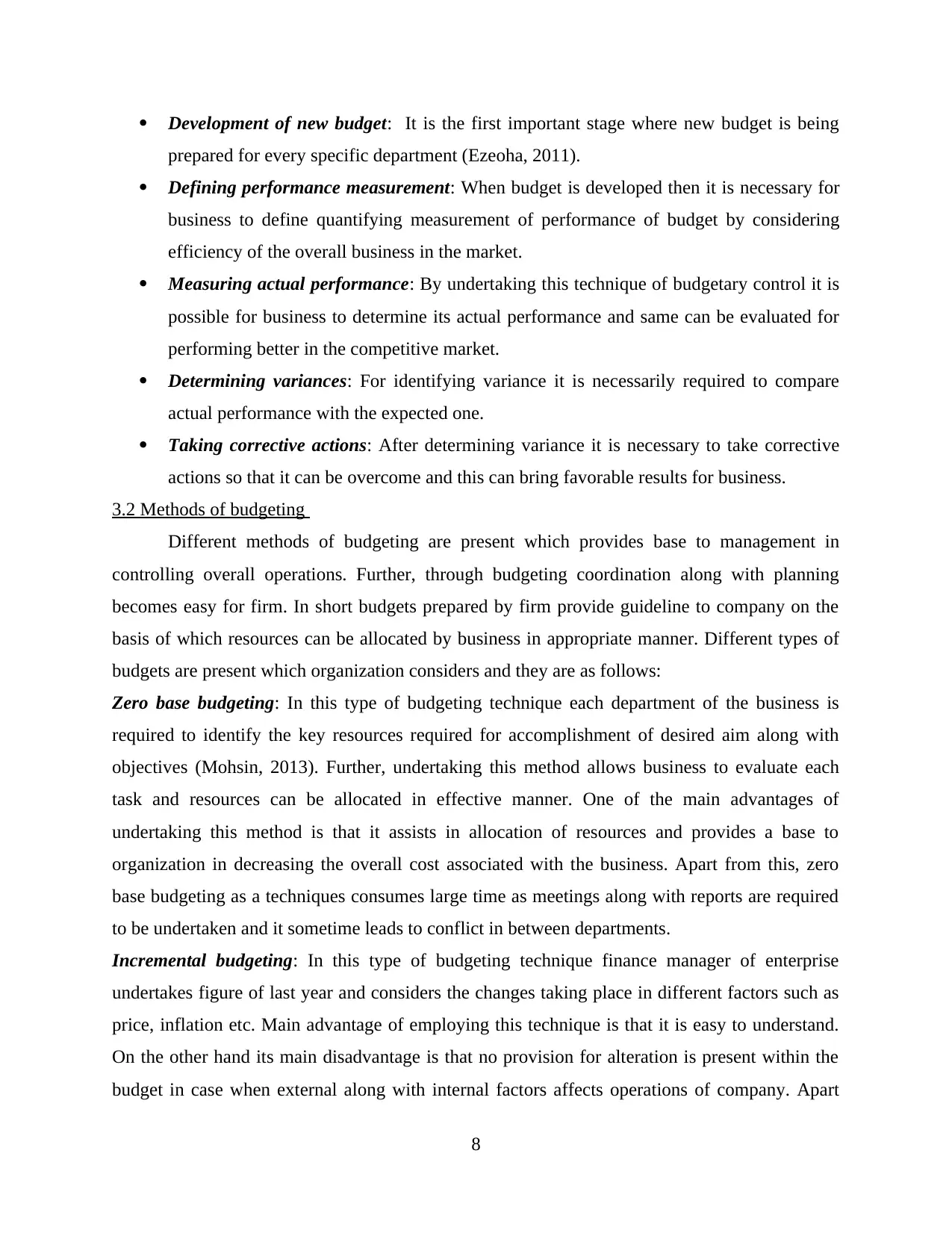
Development of new budget: It is the first important stage where new budget is being
prepared for every specific department (Ezeoha, 2011).
Defining performance measurement: When budget is developed then it is necessary for
business to define quantifying measurement of performance of budget by considering
efficiency of the overall business in the market.
Measuring actual performance: By undertaking this technique of budgetary control it is
possible for business to determine its actual performance and same can be evaluated for
performing better in the competitive market.
Determining variances: For identifying variance it is necessarily required to compare
actual performance with the expected one.
Taking corrective actions: After determining variance it is necessary to take corrective
actions so that it can be overcome and this can bring favorable results for business.
3.2 Methods of budgeting
Different methods of budgeting are present which provides base to management in
controlling overall operations. Further, through budgeting coordination along with planning
becomes easy for firm. In short budgets prepared by firm provide guideline to company on the
basis of which resources can be allocated by business in appropriate manner. Different types of
budgets are present which organization considers and they are as follows:
Zero base budgeting: In this type of budgeting technique each department of the business is
required to identify the key resources required for accomplishment of desired aim along with
objectives (Mohsin, 2013). Further, undertaking this method allows business to evaluate each
task and resources can be allocated in effective manner. One of the main advantages of
undertaking this method is that it assists in allocation of resources and provides a base to
organization in decreasing the overall cost associated with the business. Apart from this, zero
base budgeting as a techniques consumes large time as meetings along with reports are required
to be undertaken and it sometime leads to conflict in between departments.
Incremental budgeting: In this type of budgeting technique finance manager of enterprise
undertakes figure of last year and considers the changes taking place in different factors such as
price, inflation etc. Main advantage of employing this technique is that it is easy to understand.
On the other hand its main disadvantage is that no provision for alteration is present within the
budget in case when external along with internal factors affects operations of company. Apart
8
prepared for every specific department (Ezeoha, 2011).
Defining performance measurement: When budget is developed then it is necessary for
business to define quantifying measurement of performance of budget by considering
efficiency of the overall business in the market.
Measuring actual performance: By undertaking this technique of budgetary control it is
possible for business to determine its actual performance and same can be evaluated for
performing better in the competitive market.
Determining variances: For identifying variance it is necessarily required to compare
actual performance with the expected one.
Taking corrective actions: After determining variance it is necessary to take corrective
actions so that it can be overcome and this can bring favorable results for business.
3.2 Methods of budgeting
Different methods of budgeting are present which provides base to management in
controlling overall operations. Further, through budgeting coordination along with planning
becomes easy for firm. In short budgets prepared by firm provide guideline to company on the
basis of which resources can be allocated by business in appropriate manner. Different types of
budgets are present which organization considers and they are as follows:
Zero base budgeting: In this type of budgeting technique each department of the business is
required to identify the key resources required for accomplishment of desired aim along with
objectives (Mohsin, 2013). Further, undertaking this method allows business to evaluate each
task and resources can be allocated in effective manner. One of the main advantages of
undertaking this method is that it assists in allocation of resources and provides a base to
organization in decreasing the overall cost associated with the business. Apart from this, zero
base budgeting as a techniques consumes large time as meetings along with reports are required
to be undertaken and it sometime leads to conflict in between departments.
Incremental budgeting: In this type of budgeting technique finance manager of enterprise
undertakes figure of last year and considers the changes taking place in different factors such as
price, inflation etc. Main advantage of employing this technique is that it is easy to understand.
On the other hand its main disadvantage is that no provision for alteration is present within the
budget in case when external along with internal factors affects operations of company. Apart
8
Paraphrase This Document
Need a fresh take? Get an instant paraphrase of this document with our AI Paraphraser
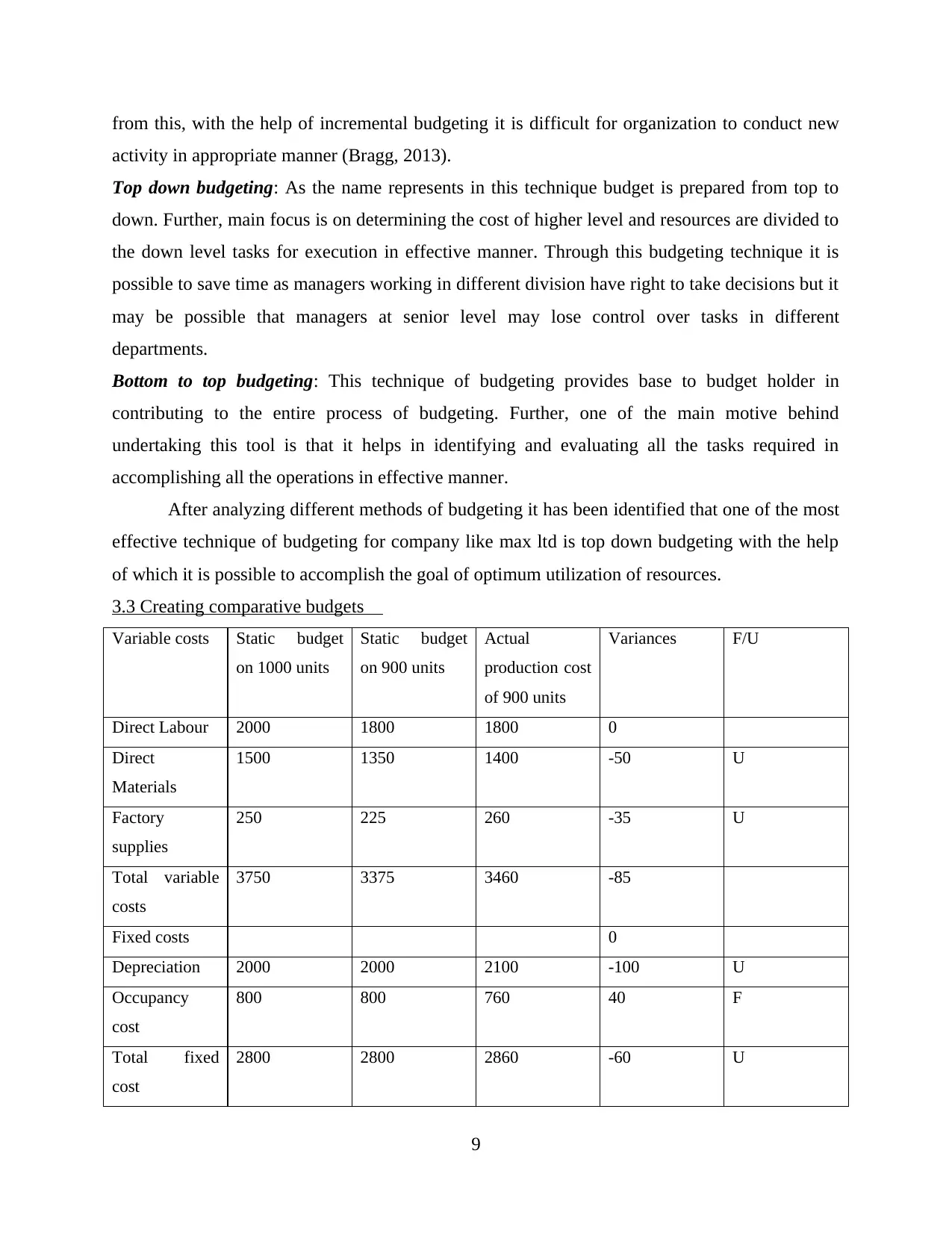
from this, with the help of incremental budgeting it is difficult for organization to conduct new
activity in appropriate manner (Bragg, 2013).
Top down budgeting: As the name represents in this technique budget is prepared from top to
down. Further, main focus is on determining the cost of higher level and resources are divided to
the down level tasks for execution in effective manner. Through this budgeting technique it is
possible to save time as managers working in different division have right to take decisions but it
may be possible that managers at senior level may lose control over tasks in different
departments.
Bottom to top budgeting: This technique of budgeting provides base to budget holder in
contributing to the entire process of budgeting. Further, one of the main motive behind
undertaking this tool is that it helps in identifying and evaluating all the tasks required in
accomplishing all the operations in effective manner.
After analyzing different methods of budgeting it has been identified that one of the most
effective technique of budgeting for company like max ltd is top down budgeting with the help
of which it is possible to accomplish the goal of optimum utilization of resources.
3.3 Creating comparative budgets
Variable costs Static budget
on 1000 units
Static budget
on 900 units
Actual
production cost
of 900 units
Variances F/U
Direct Labour 2000 1800 1800 0
Direct
Materials
1500 1350 1400 -50 U
Factory
supplies
250 225 260 -35 U
Total variable
costs
3750 3375 3460 -85
Fixed costs 0
Depreciation 2000 2000 2100 -100 U
Occupancy
cost
800 800 760 40 F
Total fixed
cost
2800 2800 2860 -60 U
9
activity in appropriate manner (Bragg, 2013).
Top down budgeting: As the name represents in this technique budget is prepared from top to
down. Further, main focus is on determining the cost of higher level and resources are divided to
the down level tasks for execution in effective manner. Through this budgeting technique it is
possible to save time as managers working in different division have right to take decisions but it
may be possible that managers at senior level may lose control over tasks in different
departments.
Bottom to top budgeting: This technique of budgeting provides base to budget holder in
contributing to the entire process of budgeting. Further, one of the main motive behind
undertaking this tool is that it helps in identifying and evaluating all the tasks required in
accomplishing all the operations in effective manner.
After analyzing different methods of budgeting it has been identified that one of the most
effective technique of budgeting for company like max ltd is top down budgeting with the help
of which it is possible to accomplish the goal of optimum utilization of resources.
3.3 Creating comparative budgets
Variable costs Static budget
on 1000 units
Static budget
on 900 units
Actual
production cost
of 900 units
Variances F/U
Direct Labour 2000 1800 1800 0
Direct
Materials
1500 1350 1400 -50 U
Factory
supplies
250 225 260 -35 U
Total variable
costs
3750 3375 3460 -85
Fixed costs 0
Depreciation 2000 2000 2100 -100 U
Occupancy
cost
800 800 760 40 F
Total fixed
cost
2800 2800 2860 -60 U
9
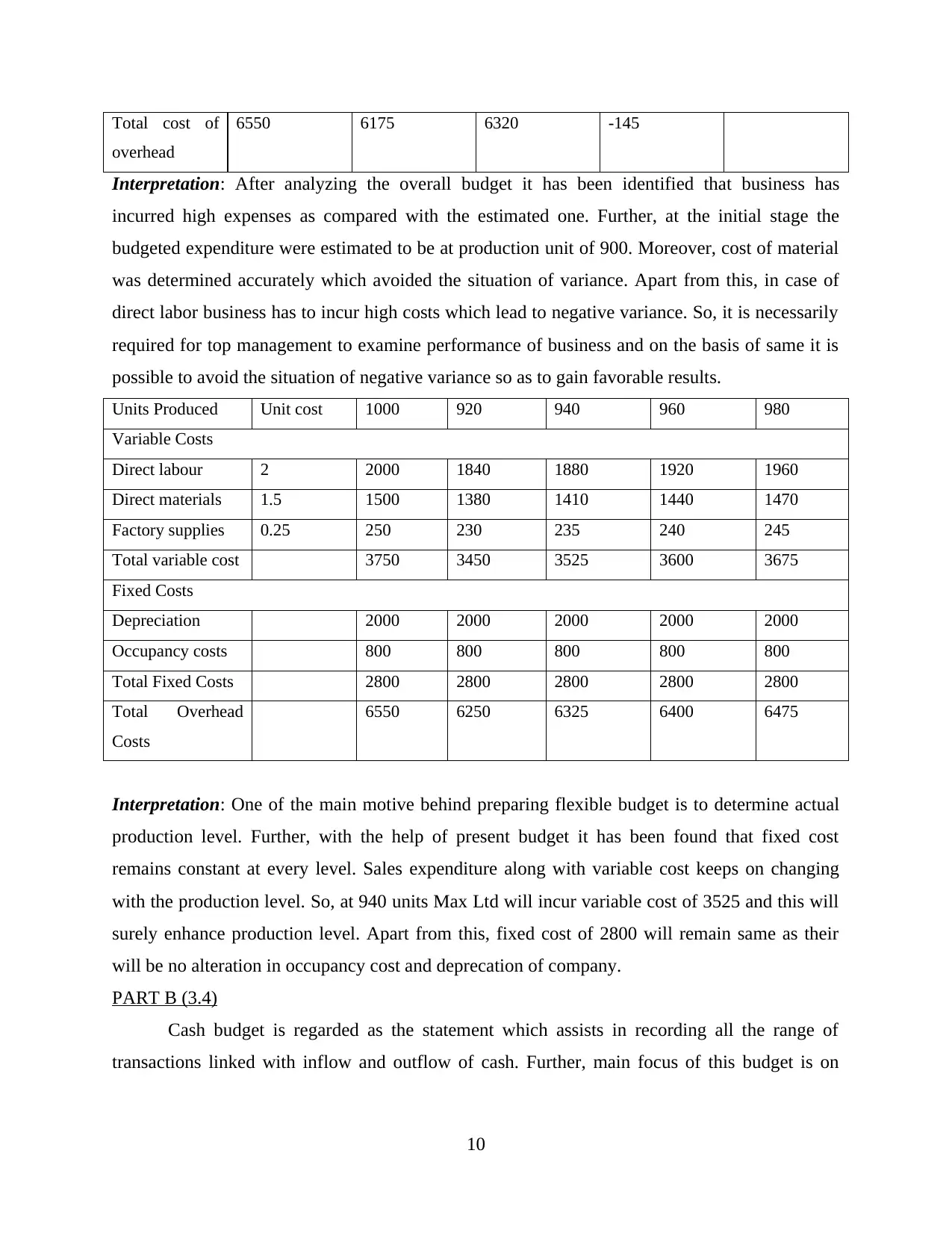
Total cost of
overhead
6550 6175 6320 -145
Interpretation: After analyzing the overall budget it has been identified that business has
incurred high expenses as compared with the estimated one. Further, at the initial stage the
budgeted expenditure were estimated to be at production unit of 900. Moreover, cost of material
was determined accurately which avoided the situation of variance. Apart from this, in case of
direct labor business has to incur high costs which lead to negative variance. So, it is necessarily
required for top management to examine performance of business and on the basis of same it is
possible to avoid the situation of negative variance so as to gain favorable results.
Units Produced Unit cost 1000 920 940 960 980
Variable Costs
Direct labour 2 2000 1840 1880 1920 1960
Direct materials 1.5 1500 1380 1410 1440 1470
Factory supplies 0.25 250 230 235 240 245
Total variable cost 3750 3450 3525 3600 3675
Fixed Costs
Depreciation 2000 2000 2000 2000 2000
Occupancy costs 800 800 800 800 800
Total Fixed Costs 2800 2800 2800 2800 2800
Total Overhead
Costs
6550 6250 6325 6400 6475
Interpretation: One of the main motive behind preparing flexible budget is to determine actual
production level. Further, with the help of present budget it has been found that fixed cost
remains constant at every level. Sales expenditure along with variable cost keeps on changing
with the production level. So, at 940 units Max Ltd will incur variable cost of 3525 and this will
surely enhance production level. Apart from this, fixed cost of 2800 will remain same as their
will be no alteration in occupancy cost and deprecation of company.
PART B (3.4)
Cash budget is regarded as the statement which assists in recording all the range of
transactions linked with inflow and outflow of cash. Further, main focus of this budget is on
10
overhead
6550 6175 6320 -145
Interpretation: After analyzing the overall budget it has been identified that business has
incurred high expenses as compared with the estimated one. Further, at the initial stage the
budgeted expenditure were estimated to be at production unit of 900. Moreover, cost of material
was determined accurately which avoided the situation of variance. Apart from this, in case of
direct labor business has to incur high costs which lead to negative variance. So, it is necessarily
required for top management to examine performance of business and on the basis of same it is
possible to avoid the situation of negative variance so as to gain favorable results.
Units Produced Unit cost 1000 920 940 960 980
Variable Costs
Direct labour 2 2000 1840 1880 1920 1960
Direct materials 1.5 1500 1380 1410 1440 1470
Factory supplies 0.25 250 230 235 240 245
Total variable cost 3750 3450 3525 3600 3675
Fixed Costs
Depreciation 2000 2000 2000 2000 2000
Occupancy costs 800 800 800 800 800
Total Fixed Costs 2800 2800 2800 2800 2800
Total Overhead
Costs
6550 6250 6325 6400 6475
Interpretation: One of the main motive behind preparing flexible budget is to determine actual
production level. Further, with the help of present budget it has been found that fixed cost
remains constant at every level. Sales expenditure along with variable cost keeps on changing
with the production level. So, at 940 units Max Ltd will incur variable cost of 3525 and this will
surely enhance production level. Apart from this, fixed cost of 2800 will remain same as their
will be no alteration in occupancy cost and deprecation of company.
PART B (3.4)
Cash budget is regarded as the statement which assists in recording all the range of
transactions linked with inflow and outflow of cash. Further, main focus of this budget is on
10
⊘ This is a preview!⊘
Do you want full access?
Subscribe today to unlock all pages.

Trusted by 1+ million students worldwide
1 out of 16
Related Documents
Your All-in-One AI-Powered Toolkit for Academic Success.
+13062052269
info@desklib.com
Available 24*7 on WhatsApp / Email
![[object Object]](/_next/static/media/star-bottom.7253800d.svg)
Unlock your academic potential
Copyright © 2020–2025 A2Z Services. All Rights Reserved. Developed and managed by ZUCOL.





